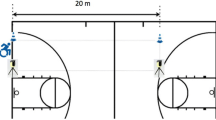Summary
To compare physiological responses and propulsion technique of able bodied subjects with no prior experience of wheelchairs (AB) and wheelchair dependent subjects (WD), ten AB and nine WD performed a 30-s sprint test in a wheelchair ergometer. The WD had spinal cord injuries with a lesion at T8 or lower. The WD and AB did not show significantly different physiological responses. The power values averaged for the right wheel over the 30 s of the test were 50.2 (SD 14.7) W and 48.0 (SD 4.4) W for WD and AB, respectively. No significant differences in torque application could be discerned, although WD subjects seemed to have a more flattened torque curve with a smaller negative deflection at the beginning of the push. The WD applied a significantly higher horizontal propulsive force to the handrims but did not apply force more effectively. The percentages of effective force to total propulsive force were 61 (SD 16)% for WD and 57 (SD 4)% for AB. With regard to the kinematic parameters, AB followed the handrims significantly longer than WD (end angle AB 65°, WD 44°), started the push phase with their arms more in retroflexion and flexed their trunks further forward. The AB did however show a movement pattern comparable to that of wheelchair athletes measured in a comparable experiment. It could not be decided conclusively that inexperience in wheelchair propulsion led to a less effective propulsion technique. Despite the selection of WD with respect to lesion level, interindividual differences in terms of level of training may have been responsible for the absence of significant results.
Similar content being viewed by others
References
Bratgård SO, Grimby G, Höök O (1970) Energy expenditure and heart rate driving a wheelchair ergometer. Scand J Rehabil Med 2: 143–148
Brown DD, Knowlton RG, Hamill J, Schneider TL, Hetzler RK (1990) Physiological and biomechanical differences between wheelchair-dependent and able-bodied subjects during wheelchair ergometry. Eur J Appl Physiol 60: 179–182
Coutts KD, Stogryn JL (1987) Aerobic and anaerobic power of Canadian wheelchair track athletes. Med Sci Sports Exerc 19: 62–65
Davis SJ (1990) An electromyographic comparison of muscles used in wheelchair propulsion by able-bodied and physically challenged adults (abstract). Thesis, San Diego State University, San Diego
Engel P, Neikes M, Bennedik K, Hildebrandt G, Rode FW (1976) Arbeitsphysiologische Untersuchungen zur Optimierung des Hebelantriebs und der Sitzanordnung beim handhebelbetriebenen Rollstuhl. Rehabilitation 15: 217–228
Eriksson P, Lofstrom L, Ekblom B (1988) Aerobic power during maximal exercise in untrained and well-trained persons with quadriplegia and paraplegia. Scand J Rehabil Med 20: 141–147
Gass GC, Watson J, Camp EN, Court HJ, McPherson LM, Redhead P (1980) The effects of physical training on high level spinal lesion patients. Scand J Rehabil Med 12: 61–65
Glaser RM, Sawka MN, Young RE, Suryaprasad AG (1980a) Applied physiology for wheelchair design. J Appl Physiol Respir Environ Exerc Physiol 48: 41–44
Glaser RM, Sawka MN, Brune MF, Wilde SW (1980b) Physiological responses to maximal effort wheelchair and arm crank ergometry. J Appl Physiol Respir Environ Exerc Physiol 48: 1060–1064
Janssen TWJ, Oers CAJM van, Woude LHV van der, Hoeven MJ van der (1990) Cardiovascular responses during activities of daily life of wheelchair users with a spinal cord injury. Proceedings 1st European Conference on the Advancement of Rehabilitation Technology (ECART), Maastricht, Nederland. Published by European Conference on the Advancement of Rehabilitation Technology published by Schrijgen-Lippertz BV Voerendaal, the Netherlands
Lees A, Arthur S (1988) An investigation into anaerobic performance of wheelchair athletes. Ergonomics 31: 1529–1537
Little J, Shure L (1988) Signal processing toolbox for use with Matlabtm. Mathworks Inc. The Mathworks, Inc. South Natick, MA, USA
Niesing R, Eijskoot F, Krause R, Ouden AH den, Storm J, Veeger HEJ, Woude LHV van der, Snijders CJ (1990) Computer-controlled wheelchair ergometer. Med Biol Eng Comput 28: 329–338
Ross SA, Brubaker CE (1984) Electromyographic analysis of selected upper extremity muscles during wheelchair propulsion. Proceedings of the 2nd Rehabilitation Engineering Society of North America its name has been changed since on and is now: RESNA, Association for the Advancement of Rehabilitation Technology Conference on Rehabilitation Engineering, Ottawa, Canada: Canadian Medical & Biological Engineering Society, pp 7–8
Samuelsson KAM, Larsson H, Tropp HT (1991) Power output and propulsion technique in wheelchair driving. Int J Rehabil Res 14: 76–81
Van der Helm FCT, Veeger HEJ (1991) A shoulder model required? Proceedings Concerted Action Comittee Biomedical Engineering (COMAC-BME), Amsterdam, 1991. Published by Faculty of Human Movement Sciences, Vrye Universiteit Amsterdam, pp 157–168
Van der Woude LHV, Veeger HEJ, Rozendal RH (1989a) Ergonomics of wheelchair design: a prerequisite for optimum wheeling conditions. Adv Phys Act Q 6: 109–132
Van der Woude LHV, Veeger HEJ, Rozendal RH, Sargeant AJ (1989b) Optimum cycle frequencies in hand-rim wheelchair propulsion. Eur J Appl Physiol 58: 625–632
Veeger HEG, Van der Woude LHV, Rozendal RH (1991a) Within-cycle characteristics of the wheelchair push in sprinting on a wheelchair ergometer. Med Sci Sports Exerc 23: 264–271
Veeger HEJ, Van der Woude LHV, Rozendal RH (1991b) A computerized wheelchair ergometer: results of a comparison study. Scand J Rehabil Med (in press)
Author information
Authors and Affiliations
Rights and permissions
About this article
Cite this article
Veeger, H.E.J., Lute, E.M.C., Roeleveld, K. et al. Differences in performance between trained and untrained subjects during a 30-s sprint test in a wheelchair ergometer. Europ. J. Appl. Physiol. 64, 158–164 (1992). https://doi.org/10.1007/BF00717954
Accepted:
Issue Date:
DOI: https://doi.org/10.1007/BF00717954




